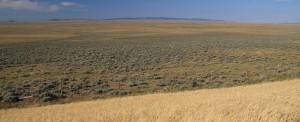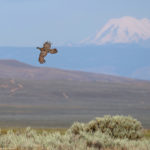Scientific Research Shows How To Reduce The Risk Of Crop Cultivation To Protect Sage Grouse

July 7, 2016
A new study explains how to cluster conservation easements in high-risk landscapes to save sage grouse

Cultivating crops like wheat (foreground) destroys vital sage grouse habitat. Photo by Conservation Media.
A new scientific study published last week in Biological Conservation explains how to reduce the threat of converting native sagebrush habitat into crops. In eastern Montana, northeast Wyoming and the Dakotas, the sagebrush sea is increasingly threatened by cropland conversion, the main threat to Greater sage-grouse. it’s imperative to protect the habitat before it’s lost forever.

New research shows different sage grouse leks’ vulnerability to converting sagebrush into cropland
A new research paper, co-authored by University of Montana PhD student Joe Smith and Sage Grouse Initiative science advisor David Naugle, compiles research on sage grouse mating leks in the northeastern portion of the bird’s range. It overlays those lek areas with data showing the landscapes most at-risk for conversion to cropland.
Smith’s paper finds that 96% of active leks are located in landscapes with less than 15% of cropland. For each ten percentage increase in cropland, scientists anticipate an associated 54% decrease in lek density. These findings will help our partners prioritize where to invest conservation dollars in order to protect prime sage grouse habitat on private agricultural lands.
“This is the first step in dealing with the biggest threat to sage grouse in the northeastern part of their range,” says Joe Smith, wildlife biologist and author of the study.

The study finds that 96 percent of active leks are found in landscapes with a proportion of cropland less than 15 percent.
In particular, this research will help target conservation easements in Montana, Wyoming, and the Dakotas. Groups like The Nature Conservancy, the Montana Land Reliance, and the Montana Sage Grouse Stewardship Fund are already using the associated cultivation risk map to pinpoint working lands that would be good candidates for this incentive-based tool.
The cultivation risk data, available for free on SGI’s web app, predicts where future breakout of new cultivation could occur based on soils, climate, and topography of existing croplands. This model was developed by Jeffrey Evans, a landscape ecologist with The Nature Conservancy and affiliate faculty at University of Wyoming.
Once native sage-steppe is converted, it’s very difficult and very costly to restore habitat. Luckily, this research predicts that investing $100 million in strategic conservation easements can prevent most habitat losses. Mapping the threat of potential crop cultivation helps put easements where sage grouse need them most, and gets the best return on investment for conservation dollars.
Read the research paper online
Download or view the cultivation risk layer on the SGI interactive web app
Read our Science to Solutions article “Reducing Cultivation Of Grazing Lands Conserves Sage Grouse“
—
The Sage Grouse Initiative is a partnership-based, science-driven effort that uses voluntary incentives to proactively conserve America’s western rangelands, wildlife, and rural way of life. This initiative is part of Working Lands For Wildlife, which is led by USDA’s Natural Resources Conservation Service.
—





